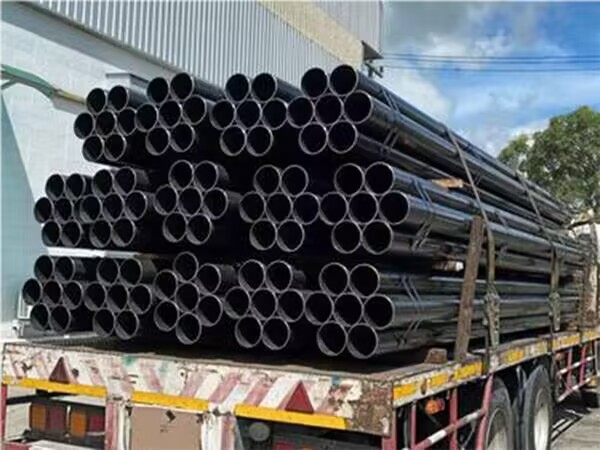Full parsing of CS seamless pipes
Carbon steel (CS) seamless pipe is one of the indispensable pipes in modern industry and engineering. It is a high-performance material with excellent strength, corrosion resistance, and versatility, and is widely used in energy, construction, chemicals, and machinery manufacturing. In this article, we will conduct a comprehensive analysis of CS
seamless steel pipe from the aspects of definition, manufacturing process, classification, common pipe types, uses and advantages.

1. What is CS seamless tube?
CS seamless steel pipe is carbon steel as the main raw material, through the seamless manufacturing process (such as hot rolled or cold drawn) made of pipes. It is different from welded steel pipes, CS seamless steel pipes do not have any weld and welding marks. CS seamless steel pipes are mainly made of thermal processing, the steel is heated to high temperatures, formed, and then quickly cooled, so they have higher strength and pressure resistance, is the first choice for many high demand scenarios.
2.CS seamless steel pipe manufacturing process
The manufacturing of CS seamless steel pipe mainly includes the following processes:
(1) Hot rolling method: the heated solid round steel billet is perforated to form a hollow tube, and then the hot rolling is carried out to gradually reduce the outside diameter and wall thickness. After forming, the final product is cooled and inspected.
(2) Cold drawing method: gradually reduce the size of the steel pipe by drawing several times at room temperature.
(3) Extrusion method: the heated billet is extruded through the mold to form the pipe.
(4) Thermal expansion method: the small and medium diameter steel pipe is heated and expanded into a large diameter pipe by expanding the diameter.
3. Classification of CS seamless steel pipe
According to different standards and uses, CS seamless steel pipes can be divided into the following categories:
Classification by production process:
Hot rolled seamless steel pipe
Cold drawn (cold rolled) seamless steel pipe
Classification by use:
Structural seamless steel pipe: used to manufacture mechanical structures and building structures.
Seamless steel pipe for fluid transportation: such as water, oil and gas pipelines.
Seamless steel pipe for boilers: high temperature and high pressure resistance, suitable for boilers and heat exchangers.
Seamless steel pipe for oil Wells: such as casing, tubing, etc., dedicated to oil exploitation.
Classification by material:
Carbon steel pipe: such as A106, A53 standard carbon steel pipe.
Alloy steel pipe: add elements (such as Cr, Mo) on the basis of carbon steel to improve performance.
Classification by pipe section shape:
Plain End (PE)
Threaded End (TE)
4. Common tube types
(1) Standard Seamless Pipe: Common for fluid transportation or structural support, with a wide range of sizes.
(2) Heavy-Wall Seamless Pipe: suitable for high pressure or high temperature environment, greater wall thickness.
(3) Boiler Seamless Pipe: Designed for boilers and pressure vessels, resistant to high temperatures and pressures.
(4) OCTG (Oil Country Tubular Goods) : including tubing, casing and drill pipe for oil and gas extraction.
5. Use of CS seamless steel pipe
CS seamless tubes are commonly used in the oil and gas industry, chemical processing, power generation and other areas where strength, durability and corrosion resistance are required.
(1) Energy industry:
Oil and gas pipelines.
High pressure boilers and heat exchangers for nuclear and thermal power plants.
(2) Construction and engineering: building support materials for Bridges and steel structure frames.
(3) Chemical industry: conveying pipelines with corrosive or high temperature and high pressure media, such as acid, alkali and gas pipelines.
(4) Mechanical manufacturing: manufacturing bearing sleeve, hydraulic cylinder and transmission shaft and other mechanical parts.
6. Advantages of CS seamless steel pipe
(1) High strength: the weld-free design eliminates the weakness of the welding point, and the tensile strength and pressure resistance are significantly improved.
(2) Excellent corrosion resistance: carbon steel material can withstand a certain degree of corrosion and can be further enhanced by coating or galvanizing.
(3) Wide range of application: suitable for a variety of conditions from low temperature to high temperature, from low pressure to high pressure.
(4) Good machinability: easy to cut, weld and bend, easy to site construction and secondary processing.
(5) Economy: Compared with stainless steel pipes, CS seamless steel pipes have a lower cost when meeting the same performance requirements.
Conclusion
CS seamless steel pipe has become an irreplaceable material in modern industry because of its excellent performance and wide application fields. From the innovation of manufacturing process to the continuous expansion of materials and uses, CS seamless steel pipe has shown strong vitality and economic value in petrochemical, energy transmission, construction engineering and other fields. In the actual selection, the appropriate specifications and types should be selected according to the specific use scenario and performance requirements to maximize its advantages.
